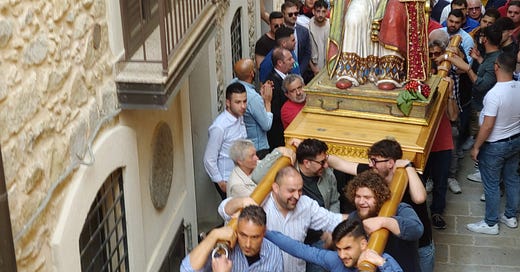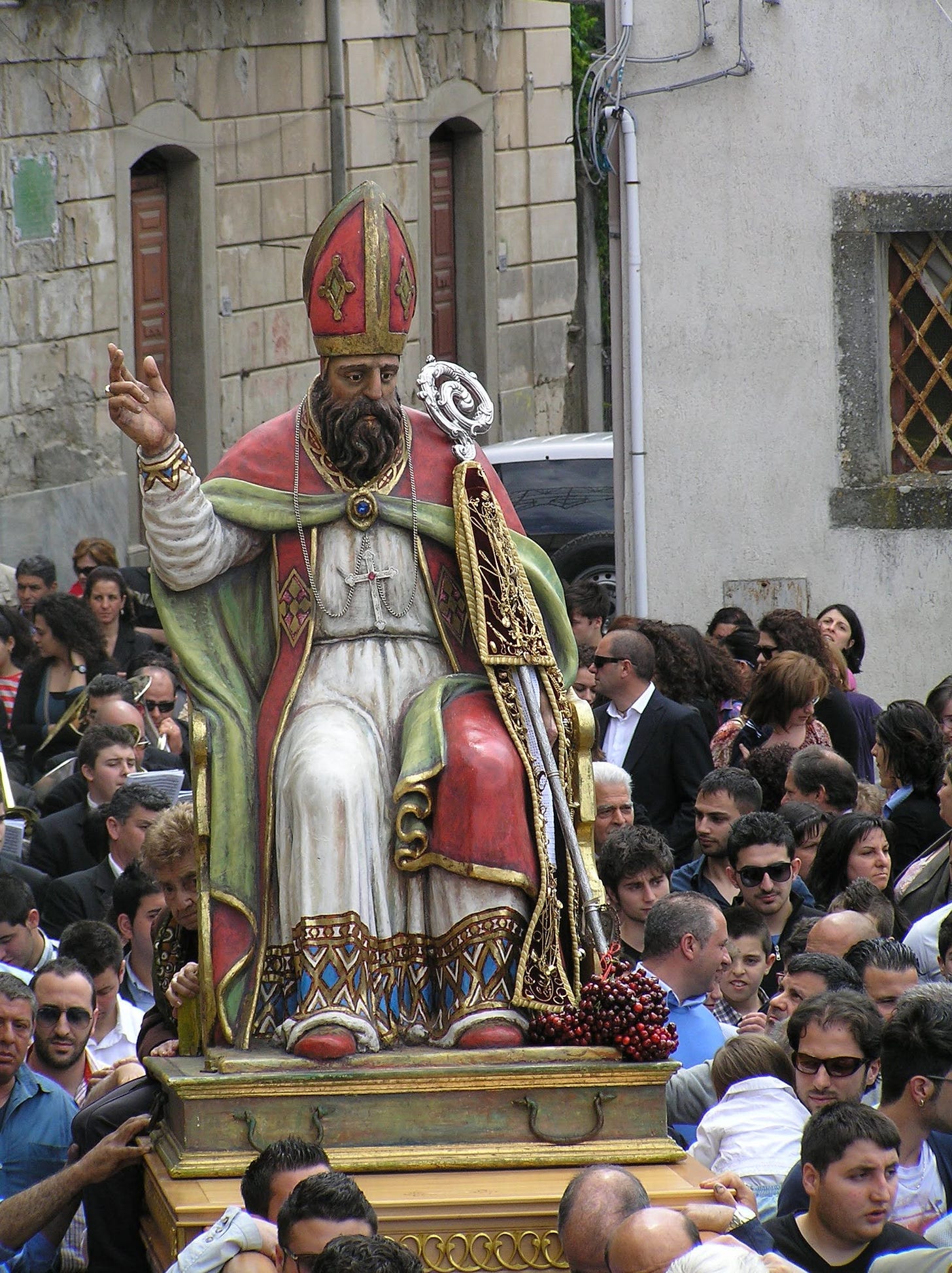Hello Friend,
This Easter, there is a very special celebration happening in my adoptive town of Sinagra Messina. Usually, the local patron saint, in this case Saint Leo, is taken on a procession which occurs on Easter Sunday.
At this time of year, the Saint's statue is housed in his country's church under the same name. On Easter night, he is taken out around the countryside around his church and all of the major hamlets and houses in a procession that usually lasts a whole afternoon into the evening when he eventually gets to the main town of Sinagra.
When he arrives in the evening at the town he is run across the main bridge over the local river and into the main Piazza. The celebration is very elaborate and filled with music and fireworks, with a lot of chanting, yelling, and praise for Saint Leo.
After the Saint reaches the main square, his procession continues through the historical Centre of Sinagra. Then, he is placed to rest for a couple of hours in the church of the convent, which is on Umberto Primo.
Finally, he is taken up to the main church of Saint Michael the Archangel, which is where he stays and abides for most of the year. The main feast day here at Sinagra is on the 8th of May, so once again, he has taken on an elaborate procession associated with religious services and tradition.
This year's celebration is particularly special because the statue has been absent from Sinagra. After all, it was being restored. The local priest has assured everyone that the restoration has gone very well and that the statue has been restored to its original colours and state.
Padre Pietro Pizzuto has repeatedly stated that the detailed decoration of the Saint's mantle Cape has been restored to 70% of its original design, recuperating an elaborate baroque vine design in gold leaf. Also, some smoke damage has been repaired, and his colours restored to those in the original statue. So, the statue that people will see for the first time in the Easter evening parade is the same one originally brought to Sinagra in the 17th century.
Now the particular wording that the parish priest at Sinagra has used seems to suggest that he is preparing everyone to see a very different Saint Leo statue to the one that had been at Sinagra before the restoration. Now I am 100% sure that the newly restored Saint Leo statue whilst being exceptionally beautiful and stunning will also solicit a certain level of controversy.
Locals are very set in their ways and very attached to their local patron Saint, so I’m sure there will be a lot of discussion about Saint Leo's new appearance. I can’t wait to see people‘s reactions and hear people‘s comments, above all, at the Easter night procession. It’s sure to be a controversy.
A little background about the Saint
The patron saint of Sinagra is Saint Leo the Bishop of Catania. He has been the saintly protector of the small Nebrodi town tucked in the provincial province of Messina for many centuries.
Saint Leone was born at Ravenna during medieval times. He was famous for his compassion and works of charity for people experiencing poverty. Above all, St Leo was a conqueror of false religions and idolatry.
In an ancient celebration, St Leo’s statue was manoeuvred around the main church of St Michael the Archangel and out into the streets of the small Nebrodi town.
With more than a hint of paganism, the festival at Sinagra is symbolic of the official beginning of Spring, and the sunshine is always on cue. Every year the locals and the town put on their best face for their beloved Patron Saint.
The 8th of May marks the big festa patronale at Sinagra, the Sicilian village where I live. Each town in Italy has its patron saint, who is celebrated yearly according to traditions. Every place has an intimate bond with its saintly protector, and gradually, through the years, they have become a part of each places folk culture
At Sinagra San Leone has been celebrated every year for as long as anyone can remember. The two world wars didn’t stop it, hard times didn’t stop it, changing times didn’t fade the locals belief and enthusiasm in their Saintly protector. Saint Leo is also the patron of Rometta and Longi. A copy of his statue has also been reproduced in Kalamunda, Western Australia.
It took a global pandemic to end the processions, the chanting, and the yelling. For two years, people were stopped from riding at the saint's feet, showering him with monetary offerings, and following him as he zig-zagged the town's small side streets. The town band was silent during this unprecedented time in recent history.
The Saint’s procession
Winding painfully slowly down the steep steps outside the Church, the statue of Saint Leo walks over the grey lava cobblestone streets, glancing over at the ruins of Sinagra’s Castello.
The bell tower clock and partial ruins remain of the medieval castle fort, which has been a stable part of the Sinagrese landscape for generations.
The Saint’s procession is evocative of hundreds of other such celebrations throughout the peninsula, Europe and the world, in an ancient tradition filled with colour, music and celebratory culture.
Saint Leo marches down Via Roma, the central commercial hub of the old town. Now dotted with hollowed-out hovels and decaying ancient palaces slowly filling up with pigeon faeces. And the odd newly restored building in a flurry of colours like a chameleon set in reverse.
This first leg of his procession is the same taken by dearly departed Sinagrese on their final cortege to the cemetery during their funerals.
On his May feast day celebration, the mood is much less sombre, and the procession is punctuated by bursts of music from the local brass band.
Chiming bells and sonic booms from cannon shots punctuate the various turns on this wandering passegiata around Sinagra and its surrounding hamlets.
Feast days usually coincide with the dates of the Saint’s birth, death or another significant event such as a miracle associated with the town.Down Via Veneto heading towards the main square, the urban-scape becomes less steep until reaching a plateau in the Piazza San Teodoro.
Continuing straight ahead, St Leo reaches the beginning of Via Umberto Primo, the old civic centre of Sinagra.
At the beginning of the street, there is the antique Church of the Crucifix with its bell tower dating back to the medieval period.
This Church is intriguing, much smaller than St Michael the Archangel, and ultimately more suggestive. The locals call it ‘the church of the convent,’ which indicates the existence of a former religious community.
The Nebrodi area has a history as a home to many religious orders and now lost convents dating back to the Crusades. The Carmelite community was born in Messina in twelve hundred and thirty-eight after arriving from the Holy Land and gradually increased through Europe.
Saint Leo makes his way past the Palazzo Salleo, arriving at the end of Via Umberto Primo. He finishes the last part of his full circle around the town, heading back into the Church of St Michael the Archangel, where he is eased back carefully into his comfortable spot at the apex of Sinagra.
The people still wish him a world of good and are content to follow in the footsteps of Saint Leo giving their praise with one last cry of: “E viva San Leone!”
Children ride at the Saint’s feet as their parent’s stuff money into an offertory box. Or discretely hand envelopes into the hands of those moving the statue. Most of the passengers on the procession are toddlers and cry when confronted by the seemingly monstrous St Leo complete with a long beard.
The children’s anxiety is whipped up to a climax by the confusion of men yelling during the procession.
The real St Leo lived during the Byzantine occupation of Sicily. His popularity and work with the poor led him to become Bishop of Catania in seven hundred and sixty.
During Saint Leo’s Bishophood at Catania, there was a famous magician named Heliodorus, who bewitched people with fake miracles and illusions. St. Leo urged the sorcerer to repent his heresies and return to the Church.
During church services given by the bishop, Heliodorus entered the Church and created a disturbance with his fake miracles and magic tricks.
Witnessing how the people came under the spell of the sorcerer’s charisma, Leo realised the time for gentle persuasion had passed. He emerged from the altar and led the magician out of the Church into the square. Saint Leo forced him to obey his actions and commanded a bonfire to be built.
The Saint was wanting to prove faith is more powerful than witchcraft challenged the magician to jump into the blaze. As they stood together in the fire, Heliodorus was burnt alive. At the same time, Leo remained unharmed protected by the power of God.
This spectacular miracle brought great fame to Saint Leo during his lifetime. As his popularity increased, his Christian love for the poor and the homeless also became well known. His charitable work with the sick gave him the skills to treat various illnesses, and he became known for his miracles.
It is the bonfire confrontation with Heliodorus which is echoed in the climax of a night time Easter Sunday procession at Sinagra which acts out the final moments of the encounter. In the parade, the Saint’s statue runs across the main bridge of the town which is lit up with pyrotechnics, under the red glow of the fireworks St Leo looks more sinister than saintly.
The strength of patron saints like St Leo has taken many saints on different journeys worldwide. Today, every major city and small town in Sicily has a saintly protector, from St Rosalia at Palermo and St Agata of Catania to the smaller villages like Sinagra, which celebrate their Saint’s feast day.
In elaborate processions, Sicilian towns and cities honour the Saint's guidance for the city and its people. The cities also follow hundreds of other saints, whose stories are as fascinating as the celebrations themselves.
That’s all I have on my mind for now.
Thanks for reading along.
Stay well, be kind to everyone, including yourself, and we’ll speak again soon.
Rochelle
Sometimes, I talk about Sicily.
Other times, I talk about whatever is on my mind.
My writing is always about lightning, the mental load, and sharing my thoughts.
I hope you enjoy the randomness of A Load Off My Mind.
Please share this post with someone you think might enjoy it.
This newsletter takes a lot of work, and I’m committed to making it available to everyone. That’s only possible because people believe in subscribing to this project, making this piece accessible to all. So please consider becoming a subscriber to A Load off My Mind.
Thanks for reading. This is a hand-crafted, ad-free, AI-free, anti-algorithm newsletter made possible by the support of readers like you. If you want to help keep it going, please become a paid subscriber.
The work and research I put into this Substack Page are entirely reader-supported. If you enjoy the content I provide and are not ready to become a paid subscriber, you can simply make a one-time donation here at Buy Me A Coffee.








And…. How was he received? How Does he look?? I’m very curious to know!!